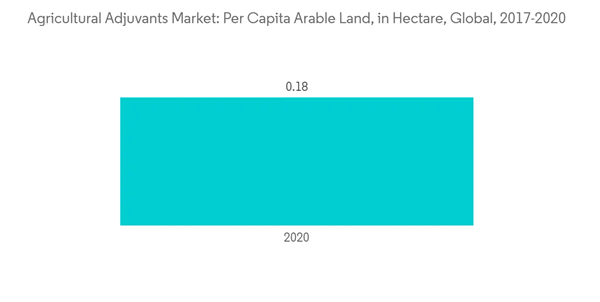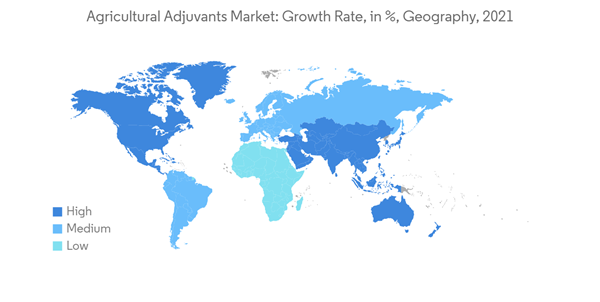The Agricultural Adjuvants Market size is estimated at USD 2.24 billion in 2024, and is expected to reach USD 2.82 billion by 2029, growing at a CAGR of 4.70% during the forecast period (2024-2029).
Furthermore, in the past 40 years, the world has lost a major portion of its arable land due to erosion or pollution, with potentially disastrous consequences for the global demand for food. The continual plowing of fields, combined with the heavy use of fertilizers, has degraded soils worldwide. Erosion occurs at a pace of up to 100 times greater than the rate of soil formation. It takes around 500 years for just 2.5 cm of topsoil to be created amid unimpeded ecological changes.
Moreover, various crop pests cause 10-16% of global crop losses annually. So, to meet the global food demand, crop protection is the key strategy farmers adopt. The use of adjuvants alongside pesticides over crops is a proven technology for increasing global food production. As per a database published by the World Bank, the area per capita for arable land declined globally from 0.19 hectares in 2017 to 0.18 hectares in 2020. Accordingly, farmers across the globe are being supported by the respective governments for the judicious use of adjuvants.
The major share of this region is attributed to crucial factors, such as a rapidly growing population, continuous reduction in the arable land, and increased demand for standard-quality food. Moreover, the factors such as shortages of agricultural labor, changing agricultural practices, growing recognition of the environmental impact of agriculture, and growing interest in sustainable production systems are further expected to support the market growth in North America.
In addition, ongoing research & development activities on improved and efficient adjuvant solutions are also anticipated to widen the scope for market growth. The government policies adopted for sustainable agricultural practices support the consumption of adjuvants, which is an additional key factor driving the growth of the studied market in the region.
This product will be delivered within 2 business days.
Key Highlights
- The agricultural adjuvants market has witnessed substantial growth in recent years owing to the growing need for sustainable pest management in agricultural operations in developed countries. Further, the need for improved agricultural productivity to meet the global food demand has imposed the increased use of crop protection chemicals, which is, in turn, driving the market for agricultural adjuvants. Increased emphasis on the improved effectiveness of crop protection chemicals in varied climatic conditions is necessitating the need for innovations in terms of the adjuvants used in them.
- Globally, several regions, including North America, Europe, and the Asia-Pacific, have imposed strict regulations on the exposure and application of genetically modified crops. The lesser production of GMO crops in this region is a crucial factor contributing to the convenient use of adjuvants in agriculture. With genetically modified crops being adopted on a large scale, the use of adjuvants would have been reduced. The farmers cultivating the GMO crops choose herbicide-resistant seeds that have been genetically modified to tackle issues for which chemicals had to be applied, thus, cutting off the requirement for adjuvants. Therefore, stringent regulations for GMO crop production in these regions have largely contributed to the growth of adjuvants.
- In addition, the factors such as growing consumer preference for environment-friendly agricultural adjuvants and increasing use of adjuvants for biological products are contributing to the market's growth.
Agricultural Adjuvants Market Trends
Growing Food Demand and Decrease in Arable Land Driving the Market
The global population is increasing exponentially. Nearly 200,000 people are getting added to the world food demand daily. According to the United States population division, the world's human population has increased nearly fourfold in the past 100 years, and it is projected to reach 9.2 billion by 2050. Thus, supplying food to the growing population has become a global threat.Furthermore, in the past 40 years, the world has lost a major portion of its arable land due to erosion or pollution, with potentially disastrous consequences for the global demand for food. The continual plowing of fields, combined with the heavy use of fertilizers, has degraded soils worldwide. Erosion occurs at a pace of up to 100 times greater than the rate of soil formation. It takes around 500 years for just 2.5 cm of topsoil to be created amid unimpeded ecological changes.
Moreover, various crop pests cause 10-16% of global crop losses annually. So, to meet the global food demand, crop protection is the key strategy farmers adopt. The use of adjuvants alongside pesticides over crops is a proven technology for increasing global food production. As per a database published by the World Bank, the area per capita for arable land declined globally from 0.19 hectares in 2017 to 0.18 hectares in 2020. Accordingly, farmers across the globe are being supported by the respective governments for the judicious use of adjuvants.
North America Dominates the Market
North America accounts for the majority of agriculture adjuvants market share. It is one of the largest markets for advanced crop protection technologies. With large acreages under crops such as corn and soybean, which consume large quantities of crop protection chemicals, the usage of adjuvants is higher. Furthermore, the usage of adjuvants is also high at the farmer level due to greater awareness of the scientific practices of crop protection.The major share of this region is attributed to crucial factors, such as a rapidly growing population, continuous reduction in the arable land, and increased demand for standard-quality food. Moreover, the factors such as shortages of agricultural labor, changing agricultural practices, growing recognition of the environmental impact of agriculture, and growing interest in sustainable production systems are further expected to support the market growth in North America.
In addition, ongoing research & development activities on improved and efficient adjuvant solutions are also anticipated to widen the scope for market growth. The government policies adopted for sustainable agricultural practices support the consumption of adjuvants, which is an additional key factor driving the growth of the studied market in the region.
Agricultural Adjuvants Industry Overview
The market for agricultural adjuvants is consolidated, with local players occupying the maximum share. Key players in the market are focusing on new product launches to cater to a broader consumer base and expand their market presence. Investments in research and development of cheap and effective products is another strategy adopted by market leaders. Some of the major players in the market are Nufarm, Bayer Cropscience, Croda International PLC, Evonik Industries AG, and Attune Agriculture.Additional Benefits:
- The market estimate (ME) sheet in Excel format
- 3 months of analyst support
This product will be delivered within 2 business days.
Table of Contents
1 INTRODUCTION
4 MARKET DYNAMICS
5 MARKET SEGMENTATION
6 COMPETITIVE LANDSCAPE
Companies Mentioned (Partial List)
A selection of companies mentioned in this report includes, but is not limited to:
- Adjuvant Plus Inc.
- Akzonobel NV
- Brandt Consolidated Inc.
- Croda International PLC
- Evonik Industries AG
- Garrco Products Inc.
- Helena Chemical Company
- Huntsman Corp.
- Interagro (UK) Ltd
- Lamberti SPA
- Momentive Performance Materials Inc.
- Nufarm
- Solvay
- Wilbur-Ellis Company
Methodology

LOADING...










